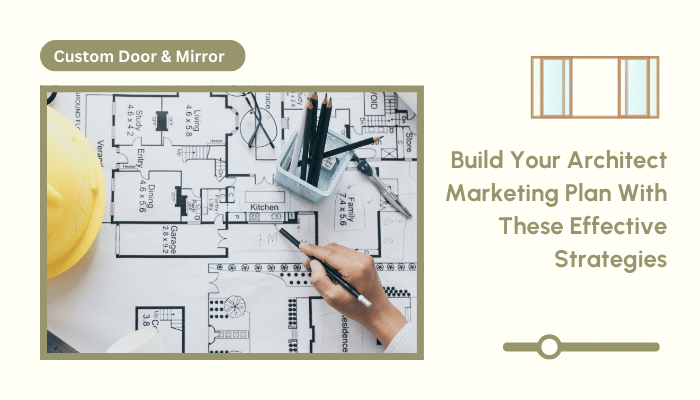The market for architectural services is experiencing record-high growth. Grand View Research valued it at USD 376.08 billion in 2023 and estimated a compound annual growth rate (CAGR) of 4.9% from 2024 to 2030.
This impressive growth can be attributed to rapid urbanization, technological advances, and the growing demand worldwide for sustainable and functional design.
However, this growth also means increased competition, which forces architectural firms to compete more strategically to gain market share and stay ahead of changing trends.
Even with this positive scenario, many architectural firms are still struggling with the feast-or-famine cycle. One month, they have many projects, and the next, they’re struggling to find new clients.
This inconsistency disrupts stability and hinders long-term growth. Marketing is often sidelined in favor of design and operational priorities. Yet a robust marketing strategy is the key to overcoming these challenges.
Ready to experience the benefits of custom closet doors? Explore our range of Paniflex products now.
This article guides architects on using marketing strategies to overcome challenges. It covers defining their target market, creating a unique selling proposition, building a strong brand, and utilizing effective modern marketing tactics.
Why a Marketing Plan Matters for Architects
A good marketing plan is not just about winning clients; it is about establishing a stable foundation for your firm’s long-term success. Marketing ensures a constant pipeline, preventing the feast-or-famine syndrome that many architectural firms suffer from. It also enables you to make plans, concentrate on growth, and better use your resources.
Unique Challenges for Architects
Architects have unique marketing challenges that other industries do not face:
- Communicating Value: The value of architectural services is intangible, making it challenging to convey to potential clients. Clients tend to focus on the bottom line without a clear understanding of the artistic and functional benefits you offer.
- Differentiation: It can be difficult to stand out in a competitive industry. Your designs might speak for themselves, but they need a compelling narrative to catch attention.
- Building Trust: Many clients are unfamiliar with the nuances of architectural services. Establishing trust and credibility is crucial to helping them choose your firm.
- Showing ROI: Clients need to know how their investment in your services can be tangibly realized in long-term savings, enhanced functionality, or aesthetic appeal.
Opportunities in the Digital Age
The digital age has changed the marketing landscape by offering new ways to overcome such challenges:
- Social Media Platforms: visual platforms like Instagram, where architects can post their designs to potential clients, and LinkedIn, which is used for professional networking and thought leadership.
- Content Marketing: Blogs, videos, and case studies will show your expertise and add value to potential clients.
- Advanced Analytics: data-driven insights help understand your audience, measure performance, and refine your strategies.
Long-Term Benefits of Strategic Marketing
An effective marketing plan provides benefits that go far beyond client acquisition:
- Brand Recognition: A consistent marketing strategy builds awareness, making your firm more memorable to clients. This ensures that your firm remains top-of-mind when clients are ready to start a project.
- Credibility: Establishing your authority in the field helps clients trust your expertise. Thought leadership content, case studies, and positive client reviews reinforce your reputation.
- Steady Growth: A perfectly created plan will ensure a constant flow of projects, reducing downtime and uncertainty. Revenue forecasting and resource planning are now clear.
- Client Retention: A strategic marketing plan not only attracts new clients but also helps maintain existing relationships by continuously engaging and updating them.
- Competitive Advantage: By developing unique selling points and innovative marketing strategies, your firm can stay ahead of the curve and establish a niche in the market.
You deserve products that match your high standards, and Paniflex delivers just that. Their commitment to quality and innovation ensures that every custom door meets your expectations.
You can trust their products to seamlessly blend functionality with aesthetic appeal, elevating the overall quality of your projects.
Whether you’re shaping an elegant interior or ensuring structural integrity, Paniflex’s solutions align perfectly with your goals.
Now that we understand the importance of a marketing plan for architects, we can learn how to identify our target market.
Identifying Your Target Market
Before effectively marketing your services, you must know who you’re marketing to. A defined target market will ensure that your efforts are focused, efficient, and more likely to produce a return on investment.
Casting too wide a net can dilute your message and waste resources, while a targeted approach helps you connect with clients who truly value what you’re offering. Here’s how you can do it.
Steps to Defining Your Target Market
Identifying your target market is the first step in creating a marketing strategy. Knowing exactly who you want to reach helps you focus your resources and craft messages that resonate with the right audience.
Attracting clients is not just about attracting them but about attracting the right clients who align with your services and vision. Let’s discuss the steps for defining your target market effectively.
- Research Demographics: Identify the age, income level, location, and other relevant details about your ideal clients. For example, are they commercial developers, residential homeowners, or government agencies?
- Understand Behaviors And Preferences: Determine how your target audience seeks out architectural services. Do they find it based on word-of-mouth, internet searches, or through industry connections?
- Identify Pain Points: Consider the potential client’s pain points if they need energy-efficient solutions, cost-effective designs, or expertise in historical restorations.
- Analyze Competitors: Identify who the competitors are targeting and gaps that you can exploit in their approach.
The next step is to learn how to tailor your marketing message. Here’s how to ace it.
Tailoring Your Marketing Message
Now that you have a clear picture of your target audience use this information to craft messages that speak directly to their needs and desires.
- Understand the Pain Points and Goals: Knowing what the client seeks in an architecture partner.
- Address Challenges: Tailor solutions to directly attack issues such as cost efficiency, sustainable design, or innovative approaches.
- Highlight The Benefits: How will your firm’s expertise effectively meet these needs, and are you the best fit?
Key Elements to Focus On
- Problem-Solution Fit: Demonstrate how your services directly address client pain points, such as green construction, navigating building codes, or meeting tight deadlines.
- Value Proposition: Show benefits such as improved functionality, aesthetics, cost savings, or added property value supported by measurable outcomes.
- Connect the Emotional Touch: Through stories, client testimonials, and behind-the-scenes narratives that depict hard work and creativity.
- Future-Proofing and Innovation: Highlight your expertise in implementing technology and sustainable solutions, such as smart homes and energy-efficient systems.
Channels for Delivery
To ensure your tailored message reaches your audience, use the most effective communication channels:
- Email Campaigns: Personalize your emails with tailored offers and project highlights.
- Social Media Posts: Showcase visually engaging designs and share client success stories.
- Website Content: Create targeted landing pages and blogs that address specific audience needs.
- Presentations and Proposals: Tailor your pitches to align directly with client priorities.
Personalize every piece of communication so that it strikes a chord deep within your audience, and they will feel that your firm is the best fit for their needs.
Continuous Refinement
Your target market isn’t static either; it will change with a shift in trends, technology, and client expectations. Here is how to do it:
- Revisit Market Research: Analyze and update your market research regularly to keep strategies aligned with current trends.
- Surveys: Periodically seek feedback from clients to understand how their needs and expectations are evolving.
- Monitor Industry Innovations: Keep updated on new technologies, practices, and trends affecting the architecture industry.
- Analyze Competitors: Observe the strategies and market positioning of competitors to find gaps or opportunities.
So, how do you define your USP? Let us find out.
Defining Your Unique Selling Proposition (USP)
Your unique selling proposition is the defining element that sets your firm apart in a crowded market. It’s the answer to why potential clients should choose you over your competitors. A strong USP not only makes your firm memorable but also positions it as the clear choice for your target audience. Here are the steps to define your USP.
Steps to Define Your USP
- Identify Your Strengths: What does your firm do better than anyone else? Are you known for innovative designs, cutting-edge technology, or expertise in sustainable architecture?
- Know What the Client Values: Design your USP according to what your clients value most. For example, if your target clients value environmentally friendly solutions, highlight a successful outcome in their green practices.
- Analyze Competitors: Identify gaps in your competitors’ products that your firm can fill and their strengths.
Examples of Strong USPs
- Innovative Design Excellence: Demonstrate ability to create unique and visionary designs that are innovative while balancing creativity with functionality. Show examples of projects that won awards or were praised by clients for originality.
- Sustainable Expertise: Highlight your leadership in green and energy-efficient architecture. Discuss the use of sustainable materials, renewable energy integrations, or LEED certifications.
- Exceptional Client Service: Demonstrate your commitment to client satisfaction by being proactive, transparent, and collaborative. Include testimonials or examples of times when you went the extra mile for clients.
- Technical Expertise: To meet modern architectural needs, showcase your proficiency in state-of-the-art tools, technologies, and methodologies, such as BIM (Building Information Modeling) or smart building integrations.
- Market Niche Specialization: To attract targeted clientele, position your firm as an authority in a specific domain, such as historical restoration, urban planning, or luxury residential design.
Communicating Your USP
Your USP should be reflected in every aspect of your marketing, from your website and social media profiles to client presentations. Consistently showcase the key elements of your USP through case studies, testimonials, and portfolio highlights.
Now, let us learn about how to develop your brand. Here’s how you can do it.
Developing Your Brand
Your brand is more than a logo-it’s the very essence of your firm’s identity and a critical driver of client perception. A strong and consistent brand ensures your firm is memorable, trustworthy, and differentiated from competitors.
Key Elements of Branding
- Visual Identity: Branding elements such as logos, color schemes, and typography must be created to represent your firm’s personality and core values. These elements must resonate with your target audience.
- Tone and Voice: Establish the tone for your company through its voice: formal, modern, or warm. Be disciplined in all voice and written work.
- Core Message: Develop a brand message that encapsulates your mission, vision, and values. This message should appear across all platforms, from your website to client interactions.
Benefits Of Branding
A strong brand is the foundation of a firm’s reputation and market presence. It talks about who you are, what you believe in, and why clients should trust you. Branding appropriately helps attract clients, as well as establish lasting relationships and loyalty. These are the key reasons for developing a consistent and impactful brand identity:
- Recognition: Your firm’s powerful brand makes it easily recognizable, making it stand out in any competitive market and attracting more clients.
- Trust and Credibility: Clients will be more likely to trust and interact with firms that project a professional and consistent image, ensuring reliability and dependability.
- Loyalty: A defined brand helps create client loyalty and can make satisfied customers become advocates for your services, which results in repeat business and valuable referrals.
- Premium Positioning: A strong brand can position your firm as a premium service provider and command higher fees.
- Team Alignment: Consistent branding aligns your team around a shared vision and values, ensuring cohesive communication and service delivery.
By building a brand that reflects your expertise and values, you create a lasting impression that resonates with current and prospective clients.
Your business needs to select the right channels to promote your brand. Let us now explain how you can do this.
Strategic Marketing Tactics and Channels
Choose the right channel through which marketing could be used to target your potential customers. For instance, here are a few tactics:
- SEO: optimize the website to help increase rankings and organic visits
- Content Marketing: create free value through various blogs, videos, or podcasts so as to reach their audiences
- Social Media: targeting and reaching customers via Instagram, LinkedIn, and other social sites.
- Lead Generation Services: Use tools and technologies to expand your reach and capture leads.
Content marketing should be centered on creating content that resonates with your audience while staying true to your brand’s voice.
Now, let us learn some effective strategies for architecture marketing.
Effective Strategies for Architecture Marketing
More than just visibility, the successful marketing of an architectural firm necessitates strategies that resonate with a particular target audience and align with business objectives. Let’s discuss practical and proven tactics to enhance your outreach, build credibility, and drive consistent client engagement.
- Social Media Marketing: For instance, one would need Instagram to display visually attractive projects and LinkedIn to network and gain professional insights.
- Email Marketing: Engage potential customers with regular updates, newsletters, and project highlights.
- Content Marketing: Post blogs and videos that establish your firm’s subject matter expertise and thought leadership.
- SEO: Optimize your website to rank higher on search engines, making it easier for clients to find you.
- Website Design: Make sure your website is attractive, user-friendly, and mobile-responsive.
So, how do you set your marketing goals and budget? Let us find out.
Setting Marketing Goals and Budget
Any good marketing strategy starts from the establishment of goals and budgets. Unless clear objectives and planned resource utilization anchor efforts, efforts start going haywire and become ineffectual. Here’s how to do it:
- Define S.M.A.R.T. Goals: Set Specific, Measurable, Achievable, Relevant, and Time-bound objectives. For instance:
- Increase website traffic by 20% within three months.
- Generate 50 qualified leads per quarter.
- Improve social media engagement by 15% over six months.
- Budget Allocation:
- Channel-Specific Investment: Depending on their ROI potential and your target audience, invest in channels like SEO, content marketing, or paid social media ads.
- Short vs. Long-Term Focus: Balance spending short-term-impact tactics (such as campaigns) and long-term strategies that yield sustainable growth, such as building brand awareness.
- Experimentation Budget: 10–15% of your budget should be set aside for new marketing tools, technologies, or platforms that adapt to industry trends.
- Regular Monitoring and Adjustment: Using analytics to track performance, re-orient strategies, and rebalance resources towards more impactful activities allows for ongoing efficiency and growth.
Now that you know how to plan your business’s marketing tactics, it is equally important to implement and measure them. Let’s understand how to do that.
Implementation and Measurement
Execution is where your marketing plan comes to life and transforms ideas into action. Start by ensuring that all your campaigns and communications align with your brand identity across every channel—your website, social media, and offline materials. Consistency builds trust and reinforces your messaging to potential clients. Here’s how to do it.
1. Leveraging Analytics
- You can use tools such as Google Analytics, social media insights, and email marketing metrics to monitor your progress.
- Monitor key performance indicators, such as website traffic, lead conversions, and engagement rates, to determine whether your campaigns are performing well.
2. Reviewing and Adapting
Review your results regularly to identify what’s working and what needs improvement. Look for trends, such as which platforms generate the most leads or what type of content resonates most with your audience. Be proactive in adjusting your strategies to improve outcomes.
3. Continuous Optimization
Marketing is a process that must be iterated. Try out new channels, content formats, or messaging styles to find what works best. Don’t hesitate to refine or pivot strategies based on your findings. Continuous optimization ensures that efforts remain relevant and impactful, thus keeping your firm competitive in an ever-changing market.
Engaging with Professional Help
Marketing for architectural firms can be complex and time-consuming, especially when juggling design work and client projects. Agencies specializing in architecture can be game-changers. These experts have a deeper understanding of the industry, enabling them to develop strategies customized to your firm’s unique strengths and goals.
Benefits of Professional Help
- Expertise and Insights: Marketing experts can track the trends, audience preferences, and the most effective channels to amplify your reach.
- Customized Campaigns: Agencies can devise campaigns tailored to your brand and target market to have maximum effect.
- Time Saved: You save time by delegating marketing tasks while experts handle promotions, allowing you to focus on core architectural work.
- Measurable Results: Professionals use advanced tools to track performance metrics and provide data-driven insights, ensuring that your marketing delivers ROI.
Choosing the Right Partner
When choosing an agency, look for:
- A portfolio of work with other architectural or design firms.
- Strong client testimonials and case studies.
- Knowledge of your niche, be it sustainable design or luxury properties.
Long-Term Impact
Investing in professional help can escalate your marketing activities, help create a brand, and achieve the consistency of acquiring new clients. It can be a momentum-building catalyst for sustainable growth and long-term success.
Ready to experience the benefits of custom closet doors? Explore our range of Paniflex products now.
Conclusion
An architect marketing plan is the cornerstone of your firm’s growth and success. By identifying your target market, defining your USP, developing a strong brand, and implementing effective strategies, you can attract the right clients and achieve your business goals.
Furthermore, leveraging data-driven insights and adapting to industry trends ensures your marketing efforts remain relevant and impactful.
Remember, marketing is a continuous process—plan, implement, evaluate, and adjust your strategies to stay ahead. Stay consistent, embrace innovation, and watch your architectural firm thrive in a competitive and evolving industry.
With advancements like BIM and virtual reality, key plans are becoming dynamic tools. Start your next project with a reliable key plan, and let Paniflex help bring your vision to life. Book a free call today to see how Paniflex can support your success!






